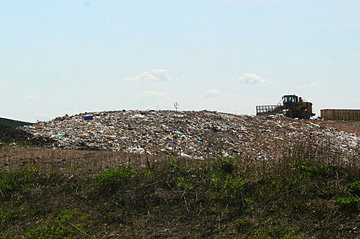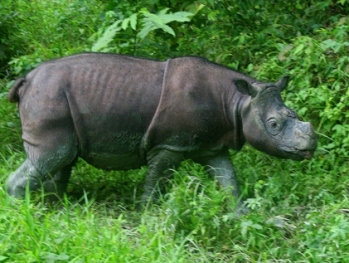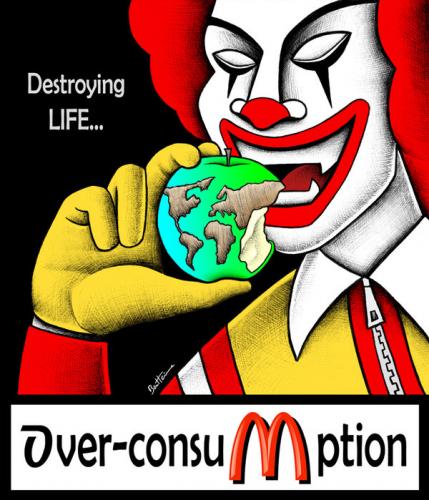WWF: “En el 2030 se necesitarán dos planetas para satisfacer el consumo de recursos naturales”
LA UE CONSUME EL TRIPLE DE LO QUE PUEDE DAR EL PLANETA
Así lo indicó la organización ambientalista en el “Informe Planeta Vivo”, estudio que desde 1998 ofrece información sobre el estado de la Tierra
Berlín (DPA) . El estado de salud de la Tierra es alarmante. Mil millones de personas no tienen acceso suficiente al agua potable, las poblaciones de vertebrados en las zonas tropicales bajaron un 60 por ciento desde 1970 y un 70% de las poblaciones de peces están amenazadas por la sobrepesca.
Estos datos están incluidos en el “Informe Planeta Vivo”, presentado hoy en todo el mundo por el Fondo Mundial para la Naturaleza (WWF). Este reporte ofrece desde 1998 información sobre las condiciones ambientales de la Tierra, comparándolo con datos de hasta 1970.
Si se repartiera la superficie del planeta de manera equitativa, a cada persona la corresponderían unas 1,8 hectáreas. Este índice refleja el área actualmente disponible para cada habitante para producir los recursos y absorber las emisiones.
Pero desde la década de 1970, la humanidad supera la capacidad regenerativa del planeta, denominada biocapacidad global, y requiere de 2,7 hectáreas por persona. Por lo tanto, la Huella Ecológica, que analiza la demanda humana sobre los ecosistemas, es 1,5 veces mayor a lo que debería ser en el caso de un consumo sostenible.
Los países que tienen la mayor Huella Ecológica son Emiratos Árabes Unidos, con más de diez hectáreas globales per cápita, seguido por Qatar, Dinamarca, Bélgica y Estados Unidos.
En el otro extremo de la tabla figuran Timor Oriental, Bangladesh y Afganistán, con unas 0,5 hectáreas.

"discúlpame pibe ... lo voy a necesitar para hacer caminar mi automovil"

USO DE RECURSOS NATURALES
En la actualidad, “se necesitan 1,5 años para que la Tierra regenere los recursos utilizados en el 2007 y absorba el dióxido de carbono emitido”. Sin embargo, WWF advirtió que si la tendencia continúa, para el año 2030 la humanidad utilizará los recursos de dos planetas. Y los países industrializados viven a expensas de los países emergentes y en vías de desarrollo.
Esto también se refleja en la evolución de la biodiversidad, indicada en el informe.
Los expertos del WWF observaron en las regiones tropicales un retroceso del Índice Planeta Vivo (IPV), un indicador de las tendencias de casi 8.000 poblaciones de vertebrados de más de 2.500 especies, de un 60 por ciento, mientras que el IPV templado aumentó cerca del 30 por ciento.
En general, “la salud de los ecosistemas ha disminuido un 30 por ciento”, dice el informe.
Sin embargo, esto no significa necesariamente que los ecosistemas templados estén en mejor estado que los ecosistemas tropicales.
“El aumento del IPV templado desde 1970 puede deberse al hecho de que empieza en una línea de referencia más baja y de que las poblaciones de especies se están recuperando gracias a la mejora del control de la contaminación y gestión de residuos, una mejor calidad del aire y el agua, un aumento de la cubierta forestal o también a esfuerzos mayores de conservación en al menos algunas regiones templadas”, se explica en el reporte.
En cambio, en las regiones tropicales la situación es totalmente diferente: “el IPV tropical comienza probablemente desde una línea de referencia más alta y refleja cambios ecosistémicos a gran escala” desde 1970.
En el Indopacífico, la biodiversidad bajó un 66 por ciento desde 1970, en Sudamérica un 55 por ciento.
DESAFÍOS A CORTO PLAZO
Sin embargo, para WWF, la “actual crisis económica ofrece una oportunidad única para reevaluar el modelo de desarrollo e iniciar la ruta hacia la sostenibilidad”.
En este sentido, la organización ambientalista identificó dos desafíos prioritarios: abastecer a la población mundial en constante crecimiento con alimentos y energía, y repartir de manera justa y equitativa los recursos naturales disponibles.
La Conferencia sobre Biodiversidad de Naciones Unidas, que comenzará el lunes en Japón, podría constituir una buena oportunidad para establecer las primera medidas para cumplir con estas metas.
| LA UE CONSUME EL TRIPLE DE LO QUE PUEDE DAR EL PLANETA |
| BRUSELAS, 13 (ANSA) - Si todos los habitantes de la Tierra vivieran como los 500 millones de la Unión Europea se necesitarían casi tres planetas para satisfacer sus demandas de consumo.
"La UE, dijo Tony Long, director de la oficina para políticas europeas del WWF, es una de las regiones más ricas y densamente pobladas del mundo, pero estos niveles de bienestar los logra a costa de los países en desarrollo y las futuras generaciones". Para Long, "la UE es un gran 'deudor ecológico que los recursos del planeta no podrán sostener por mucho tiempo más". Según el informe, en promedio los 27 estados miembros de la Unión Europea consumen casi el doble de los recursos naturales respecto al promedio global. La nota positiva es que las zonas templadas como Europa muestran señales de reaparición de especies, debido a los esfuerzos de conservación y al mejoramiento de los controles de residuos y de la contaminación. DFB |
![]()
Humanity consuming the Earth: by 2030 we’ll need two planets
http://news.mongabay.com/2010/1013-hance_consumption.html
Too many people consuming too much is depleting the world’s natural resources faster than they are replenished, imperiling not only the world’s species but risking the well-being of human societies, according to a new massive study by the World Wildlife Fund (WWF), entitled the Living Planet Report. The report finds that humanity is currently consuming the equivalent of 1.5 planet Earths every year for its activities. This overconsumption has caused biodiversity—in this case, representative populations of vertebrate animals—to fall by 30 percent worldwide since 1970. The situation is more dire in tropical regions where terrestrial species’ populations have fallen by 60 percent and freshwater species by 70 percent.
Produced in collaboration with the Zoological Society of London (ZSL) and the Global Footprint Network the biannual report follows the health of nearly 8,000 animal populations across 2,500 representative species. For example, the white-rumped vulture’s population has collapsed by 50 percent from 2000-2007, while leatherback marine turtles’ population has dropped by 20 percent from 1989-2002. The report finds that there are five major causes for such species’ population crashes: habitat loss, over-exploitation, pollution, invasive species, and climate change. All of these threats are linked to human consumption patterns.
“[Human consumption] demands are largely met by a few key sectors: agriculture, forestry, fisheries, mining, industry, water and energy. Together, these sectors form the indirect drivers of biodiversity loss,” the report explains. “The scale of their impact on biodiversity depends on three factors: the total number of consumers, or population; the amount each person is consuming; and the efficiency with which natural resources [used].”
 Landfill in Minnesota, US. Photo by: Jeremy Hance |
The tropics are the most threatened region. Industrial agriculture, livestock, mining, oil and gas, and infrastructure such as roads have led to large-scale and on-going deforestation in tropics, where the majority of the world’s biodiversity lives.
“The decline of tropical forests is well-reflected in population trends of individual species like tigers, elephants and rhinos, which need these habitats to survive. In Riau province on the island of Sumatra, we have lost 65 percent of forest cover in 25 years and as a result, tiger populations have decreased by about 70 percent and elephants by 84 percent,” says Dr. Sybille Klenzendorf, Managing Director of WWF’s Species Conservation Program in a press release. “What we need to realize is that the consumption of vital commodities that are harvested in these areas, such as paper and oil palm […] are devastating important habitats and destabilizing our climate. It is time we look at more sustainable ways of living and sourcing commodities to save ourselves, our children, and the species we care about.”
As Klenzendorf point out the loss of natural ecosystems isn’t just impacting tigers, rhinos, and elephants. Services from nature that humanity depends on, known as ‘ecosystem services’, are being degraded and lost due to the expanding human footprint. Such ecosystems services include freshwater availability, pollination, climate stability, food production, erosion and flood control, and future medicines. While humans are dependent on water for survival, the report’s Water Footprint of Production finds that 71 nations are seeing stress on their non-renewable water sources, a trend that’s expected to grow worse as the climate continues to warm.
As expected some regions consume more than others. For example, if everyone on Earth consumed as much as the average American, global society would need 4.5 Earths to achieve sustainability instead of 1.5.
“Rich nations must find ways to live much more lightly on the Earth—to sharply reduce their footprint, including in particular their reliance on fossil fuels. The rapidly-growing emerging economies must also find a new model for growth—one that allows them to continue to improve the wellbeing of their citizens in ways that the Earth can actually sustain,” James P. Leape, Director General of WWF International, writes in the report.
 A Sumatran rhino in captivity in Borneo. The Sumatran rhino is on the edge of extinction with only 200 individuals estimated to survive. Photo by: Jeremy Hance. |
One bright spot is that species populations in the temperate regions, as opposed to tropical, are on the rise as a whole. However, the report points out that this is largely due to when the first Living Planet analysis was undertaken in 1970.
“If the temperate index were to extend back centuries rather than decades it would very probably show a long-term decline at least as great as that shown by tropical ecosystems in recent times,” the authors write. However, according to the report, conservation efforts, forest re-growth, and improvements in pollution have clearly aided temperate species in the near-term.
Overall, humanity’s ecological footprint has doubled since 1966 and likely surpassed the Earth’s capacity sometime in the 1970s. Much of the ballooning footprint is linked to greenhouse gas emission, which have grown by 35 percent since 1998. According to the report, humanity needs to drastically change the way it consumes natural resources or environmental problems—and the economies that they underpin—will only worsen.
“Under a ‘business as usual’ scenario, the outlook is serious: even with modest UN projections for population growth, consumption and climate change, by 2030 humanity will need the capacity of two Earths to absorb CO2 waste and keep up with natural resource consumption,” the report reads.
By the time the global population is expected to stabilize at around 9 billion people in 2050, 2.8 Earths will be necessary if ‘business as usual’ continues.
To avoid this fate and achieve true sustainability, the report makes a number of recommendations, for example: measure human well-being as more than just GDP; protect 15 percent of the world’s land and marine regions; enhance land productivity; employ a new economic system for valuing ecosystems and biodiversity; eliminate perverse subsidies; and build a green energy economy, rapidly phasing out the need for fossil fuels, among others.
“Sustainability should not be an option for consumers. Consumers should have only good choices. The science is clear: current ways of doing business undermine the competitiveness of companies and, ultimately, the life support systems of the planet. As such, they threaten companies’ ability to continue producing products,” says Dr. Jason Clay, WWF Senior Vice President, Market Transformation.

A map of the water footprints of different countries around the world.http://www.waterfootprint.org/?page=files/home






/http%3A%2F%2Fwww.contrainjerencia.com%2Fwp-content%2Fuploads%2F2014%2F07%2Ftimthumb.php_1.jpg)
/http%3A%2F%2Fwww.radio36.com.uy%2Fentrevistas%2F2014%2F08%2F01%2Fclip_image002_0546.jpg)
/http%3A%2F%2Fwww.radio36.com.uy%2Fentrevistas%2F2014%2F08%2F01%2Fclip_image002_0545.jpg)
/http%3A%2F%2Fimg.youtube.com%2Fvi%2FIq04dnHwpYc%2F0.jpg)
